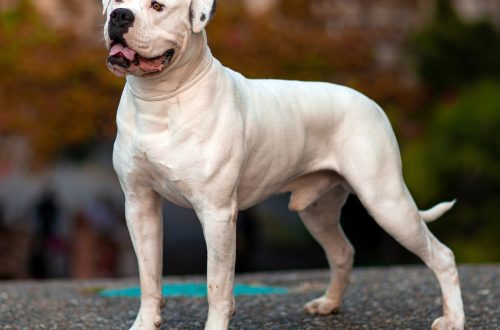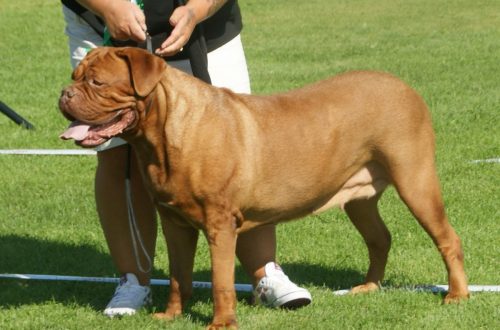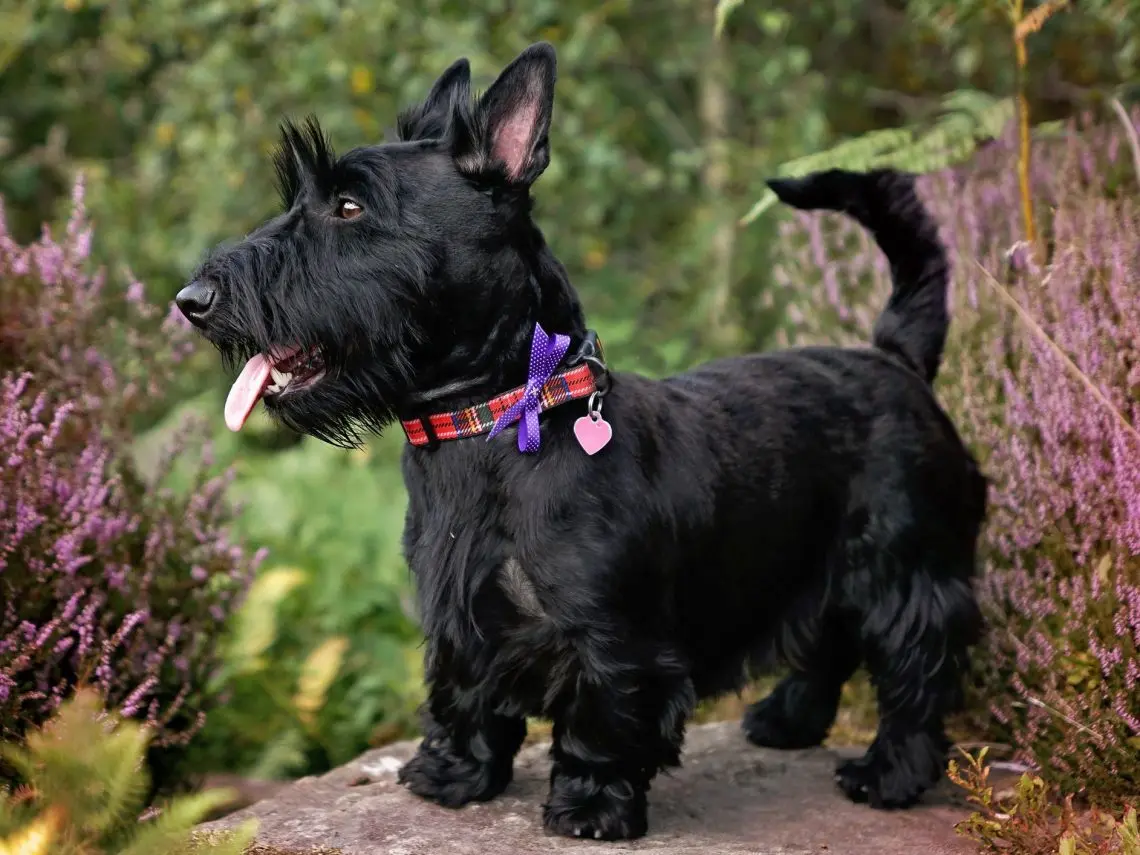
Scottish Terrier
Contents
- Characteristics of Scottish Terrier
- Basic moments
- History of the Scottish Terrier breed
- Video: Scottish Terrier
- Appearance of the Scottish Terrier
- Photo of Scottish Terrier
- Scotch Terrier personality
- Education and training
- Hunting with Scottish Terrier
- Maintenance and care
- Health and disease of Scottish Terriers
- How to choose a puppy
- Photo of Scotish Terrier puppies
- Scottish Terrier price
Characteristics of Scottish Terrier
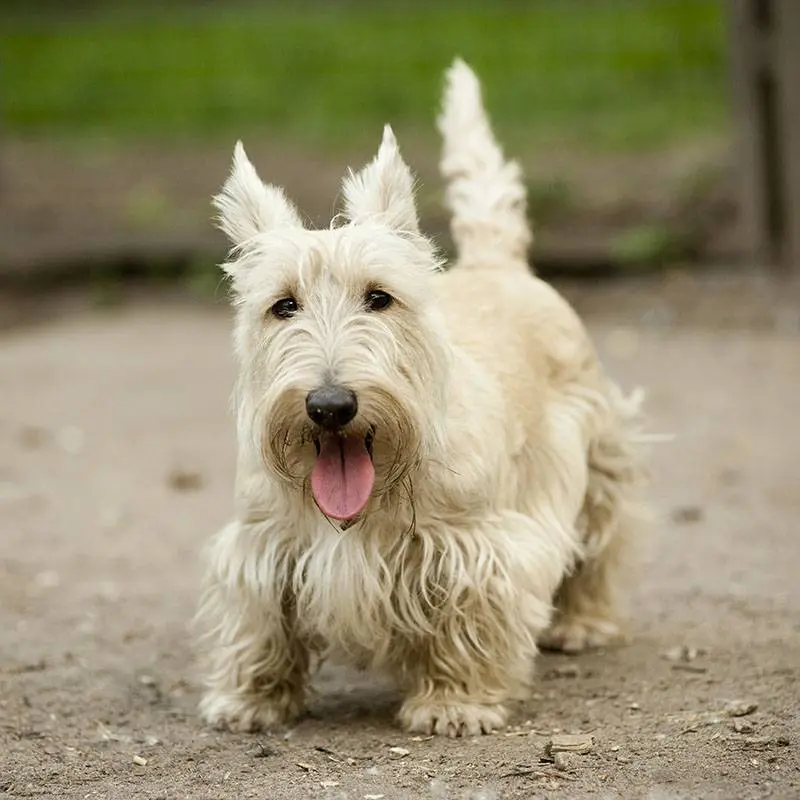
Other names: Scotch Terrier , Scotty
The Scottish Terrier or Scottish Terrier, once an unsurpassed specialist in burrow hunting, today is a spectacular city companion. Pointy-eared, compact, has a hard shaggy coat.
| Country of origin | Scotland |
| The size | small |
| Growth | 25-28 cm |
| Weight | 8.5-10.5 kg |
| Age | up to 12 years |
| FCI breed group | terriers |
Basic moments
- The Scottish Terrier has a couple of alternative names by which dog people identify it. So, for example, a dog is often referred to as Scotty or a gentleman in a skirt.
- The recognizable appearance of Scottish Terriers is often used in advertising campaigns. For example, on the label of Black & White whiskey, you can see a Scottish terrier paired with its snow-white relative – the West Highland.
- The voice of the representatives of this breed is low and sonorous, because of which their barking can seem annoying. But if at one time you were not too lazy to instill in the dog the norms of behavior in the apartment, she will not annoy you with “opera arias”.
- The Scottish Terrier, despite the outward comicality and compactness, bordering on miniature, is a quick-tempered, pugnacious creature and loves conflicts with other animals, in particular, with dogs of large breeds.
- A properly educated “Scot” does not make a tragedy out of his master’s absences. The main thing is not to abuse his good nature by locking the animal in the apartment for a day and depriving him of a walk.
- Scotty accepts petting favorably, but hates being forced on him, so say goodbye to dreams of cuddling a dog at any time of the day or night.
- Energy, passion for adventures and interest in everything unknown are in the blood of the breed, so just put the Scottish Terrier on the sofa and safely forget about its existence will not work. The dog needs daily emotional and physical relaxation, which she should receive during walks and communication with a person.
- Getting angry and pouting at the owner is a common thing for Scotch Terriers. The reason for resentment can be anything: a conversation with a pet in a raised voice, a ban, or even a banal refusal in another yummy.
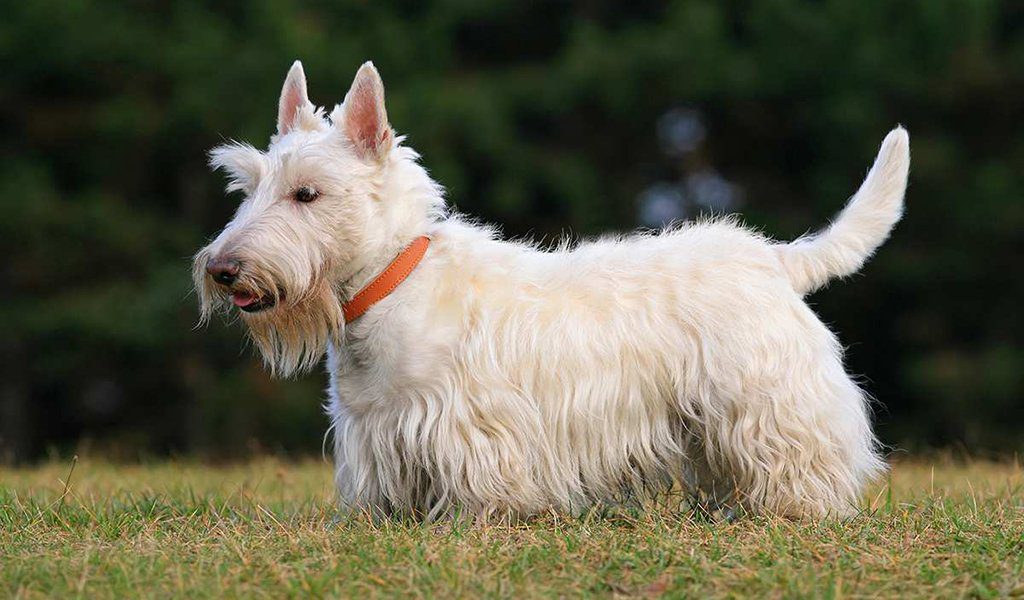

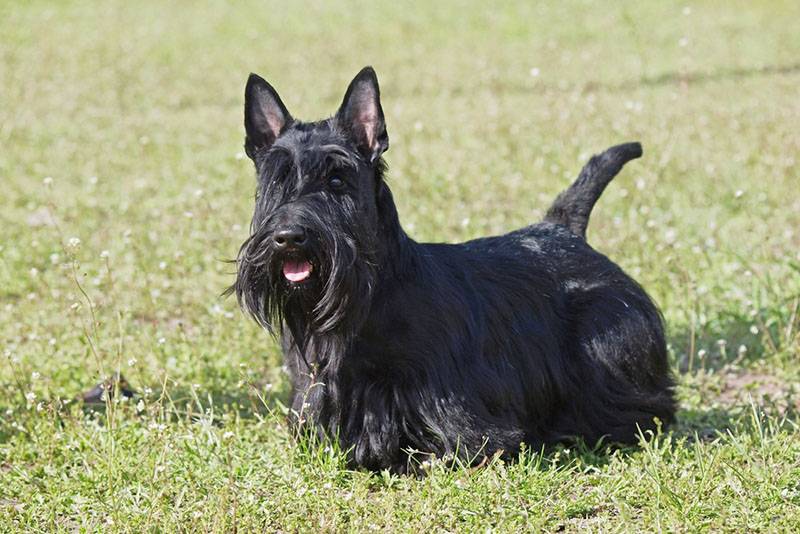
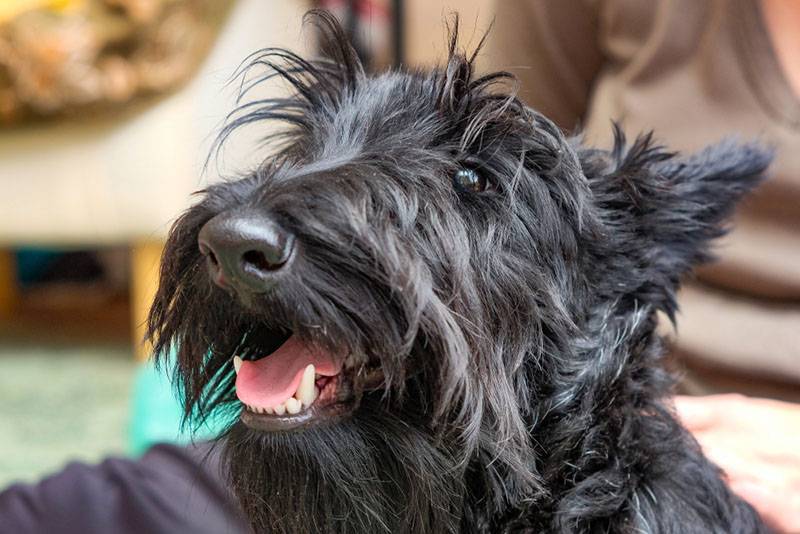
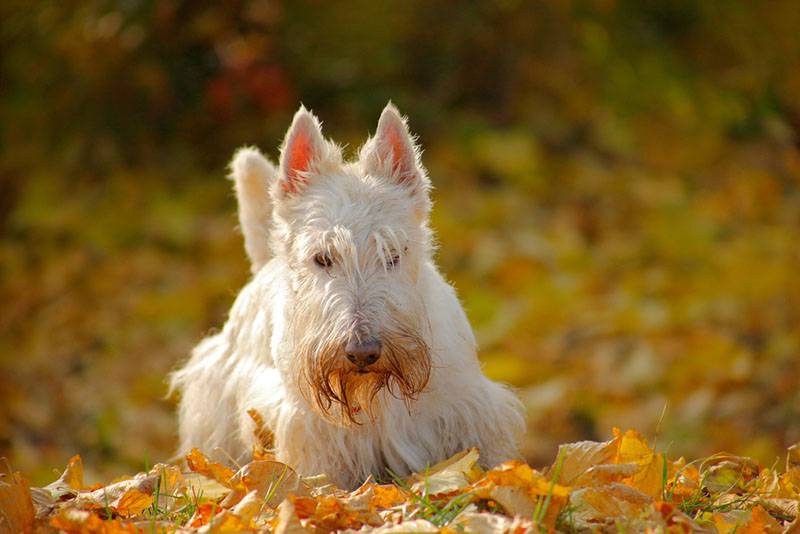
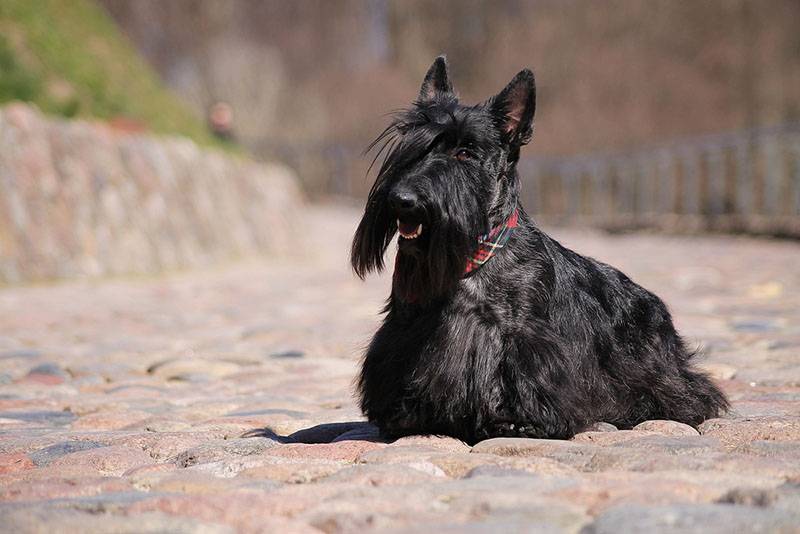
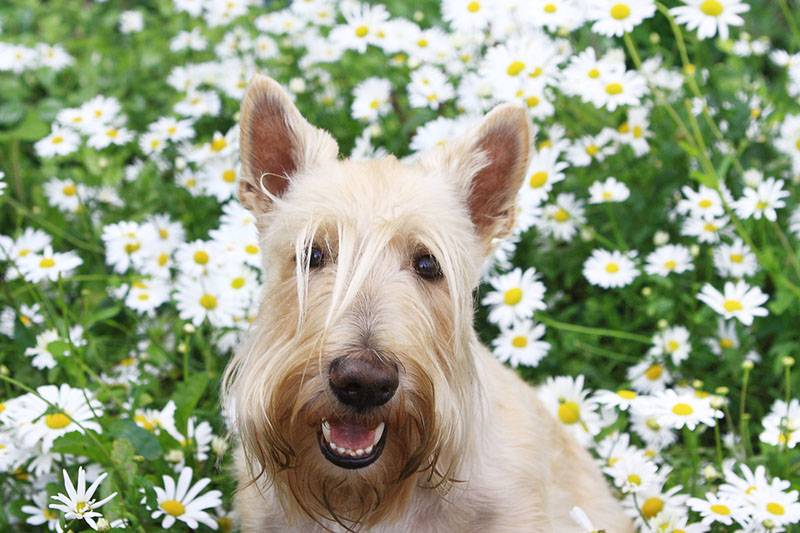
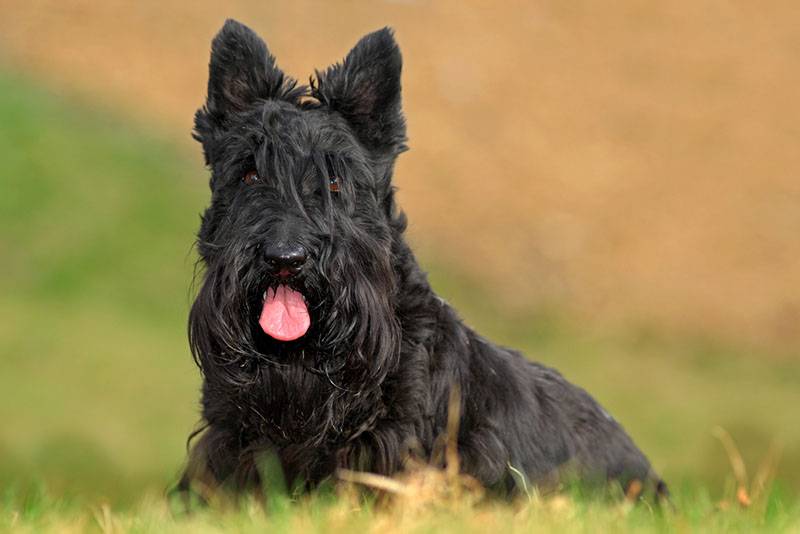
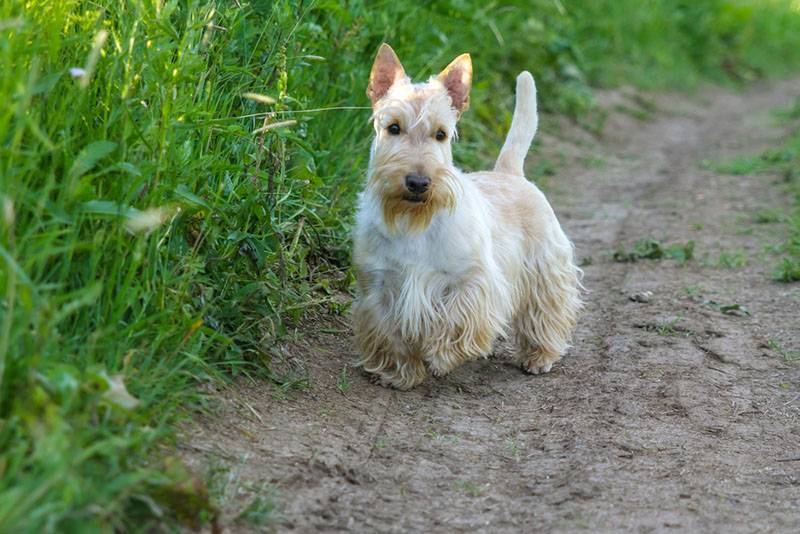
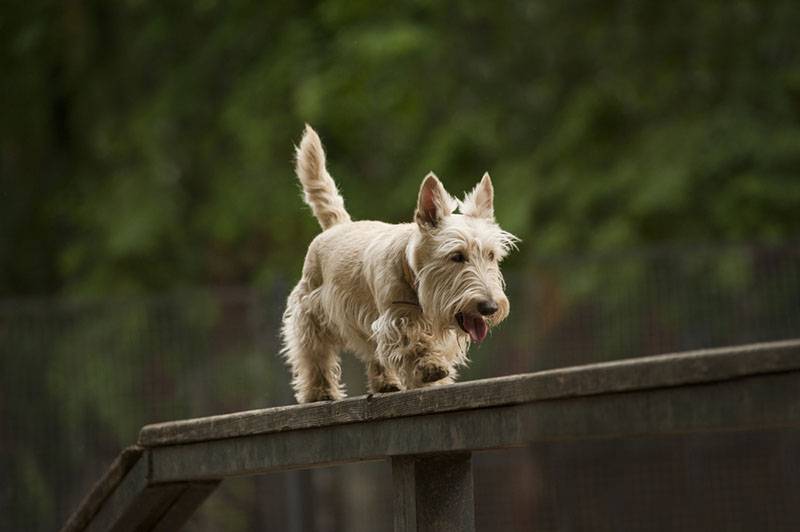
The Scottish Terrier is a tireless, bearded storyteller, a fierce debater, and a mischievous headstrong with an almost magnetic charm. In the house where the Scottish terrier lives, there is almost always a positive attitude, because next to such a dog it is impossible to remain too serious. By the way, you can have no doubt that you will have to literally be close to Scotty: representatives of this breed consider it their direct duty to take all possible part in all the undertakings of the owner.
| PROS Small size; Good performance; Courage and courage; original appearance; The molt is inactive. | CONS Can chase living creatures; Needs early socialization; They tolerate cold and rain well; They often show stubbornness. |
History of the Scottish Terrier breed

Despite the fact that Scotties are considered the oldest breed of dogs in Scotland, they managed to stand out from the numerous clan of terriers only in the middle of the 19th century. It was during this period that the paths of the short-legged Scottish and long-haired English terriers diverged, and they finally stopped crossing with each other. However, the matter never came to a real classification, therefore, for several decades, Scottish terriers were called any dogs that specialized in catching barn rats and burrow hunting. And, as you know, the West Highlands, Skye, and even Cairn Terriers were quite successful in this. Slowed down the process of formation of the breed and spontaneous breeding. According to contemporaries, every 19th-century Scottish village had its own ideal type of terrier, often carrying an unimaginable mixture of genes,
The Scottish Terriers began to form into a separate family in 1879, after the decision of the English Kennel Club to distinguish Scottish terriers into classes based on their colors. History even retained the name of one of the first breeders, who played a crucial role in separating Scottish Terriers from their fellows in the group. It turned out to be a certain Captain McKee, who in 1880 traveled around the Scottish province and bought animals with wheaten and black shades of wool from peasants. It was thanks to his efforts that in 1883 the Scottish Terriers finally received their own breed standard, completely separated from the snow-white West Highlands and the mazurka natives of the Isle of Skye.
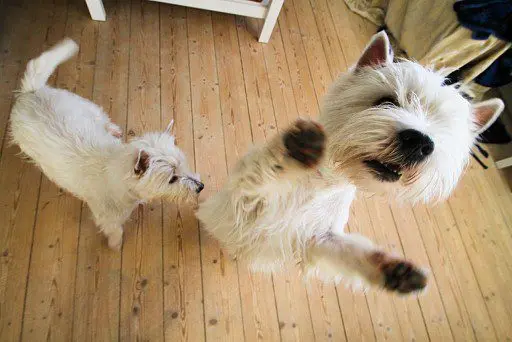
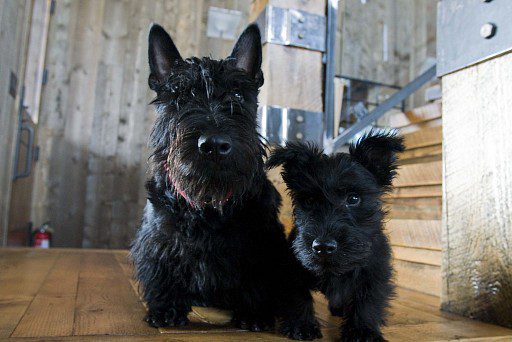
Scottish terriers came to the USA in the 80s of the XIX century, but at first they didn’t particularly hook anyone. Only after Franklin Roosevelt himself acquired a representative of this breed, universal recognition and love fell on Scotty. Scottish terriers were brought to Tsarist Russia at the beginning of the 20th century, so the first owners of these shaggy “gentlemen” were members of the grand ducal family. However, the whirlwind of revolution soon swirled the country, and the animals were quickly forgotten. The second attempt to win the hearts of Soviet dog lovers was made by the breed in the 30s, but it did not come to large-scale breeding again, since the sudden outbreak of the Great Patriotic War did not contribute to such experiments. So it was only in the mid-70s that they began to fully “stamp” Scottish terriers in the USSR,
Famous Scotch Terrier Owners:
- George W. Bush;
- Mikhail Rumyantsev (clown Pencil);
- Viktor Tsoi;
- Leonid Yarmolnik;
- Vladimir Mayakovsky;
- Leonid Utesov.
Video: Scottish Terrier
Appearance of the Scottish Terrier
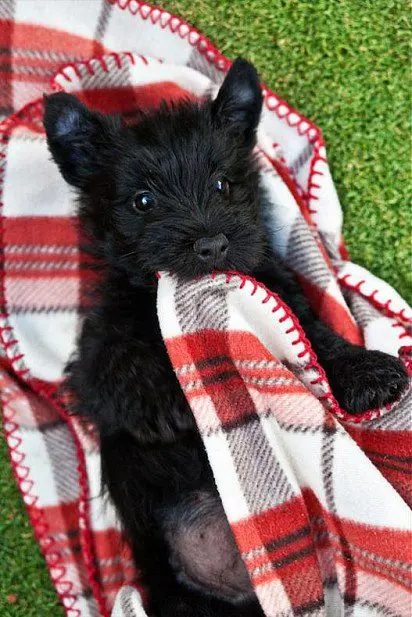
The Scottish Terrier is a squat, shaggy “Scot” with a stylish, slightly disheveled beard and short legs, masterfully coping with digging even the hardest ground. Belonging to the group of small terriers, Scotties cannot boast of an impressive physique, but you cannot call them real midgets either. The average height of an adult dog is 25-28 cm, weight is up to 10.5 kg, and these parameters are the same for both males and females.
Head
The skull of the Scottish Terrier is elongated, almost flat, with a distinct stop that fits the eyes.
Teeth and bite
All representatives of this breed have very large teeth, and the jaws are closed in a complete, scissor bite (the upper incisors completely cover the lower dentition).
Scottish Terrier Nose
The nose of the Scottish Terrier is massive, rich black in color. The line running from the lobe to the chin of the dog has a slight bevel.
Eyes
The wide-set, dark brown eyes of the Scotch Terrier are almond-shaped and slightly covered by overhanging eyebrows. The look of the dog is inquisitive, penetrating, perky.
Ears
Scottish terriers have graceful and very thin erect ears with a pointed shape.
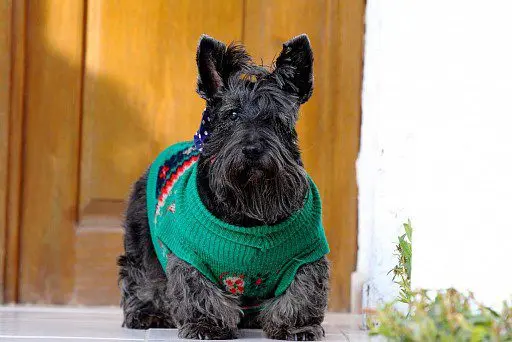
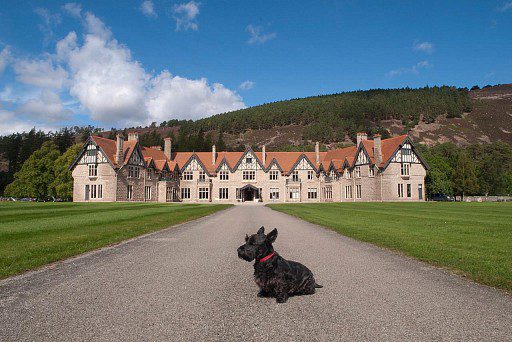
Neck
The dog’s neck is not too elongated and moderately muscular.
Frame
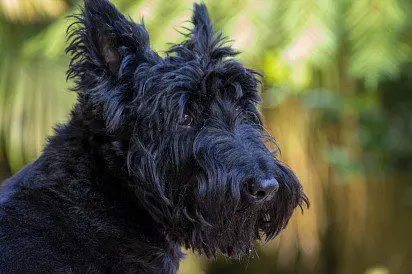
The back of the Scottish Terrier is short, with a flat, almost horizontal topline. The chest of representatives of this breed is wide, noticeably protruding forward and slightly lowered to the bottom.
Legs
The forelimbs are short, with straight, bony forearms and even pasterns. The hind legs are more massive, with large thighs and short but strong hocks. The paws of the dog are arched type, in a lump, with large pads. Despite the pronounced short-leggedness, the Scottish Terrier quite successfully copes with the loads: a forced march 10 km long and an hour and a half digging a foundation pit for Scotty is far from the most difficult job.
Tail
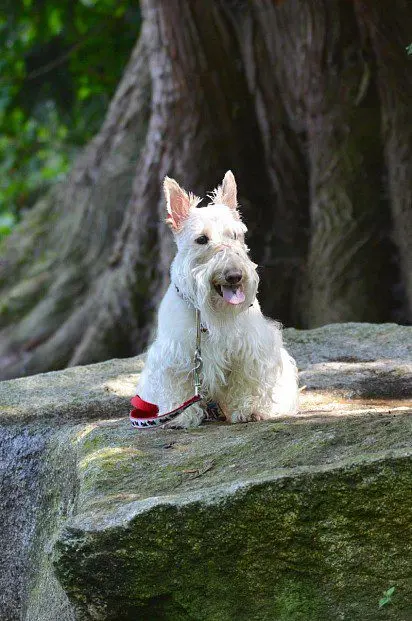
The Scotch Terrier has a small (16-18 cm) tail, thickened at the base, which is carried almost vertically. A slight tilt is also acceptable.
Wool
The coat of the Scottish Terrier is formed by a short, well-lying undercoat in combination with a wiry outer coat. The coat reaches its greatest length and density in the lower part of the dog’s body, forming the so-called “skirt” and “pants”.
Scottish Terrier Color
The correct Scotch Terrier can be black, wheaten in all its variations, or brindle. At the same time, in the case of brindle, all types of shades are considered acceptable.
Disqualifying vices
Everything here is the same as for representatives of other breeds: the exhibition committee can exclude an animal from the number of contestants for pronounced physical defects or for behavioral deviations. In particular, overly cowardly, as well as overly aggressive Scotch terriers, the entrance to the ring definitely does not shine.
Photo of Scottish Terrier
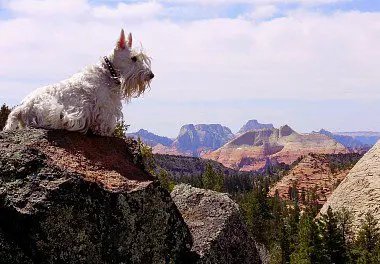
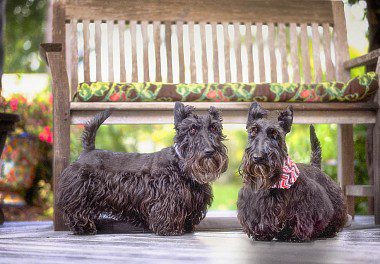
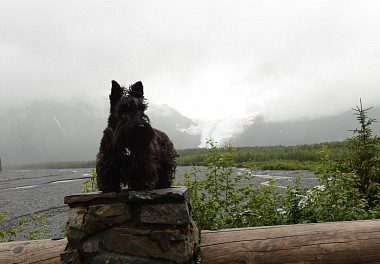
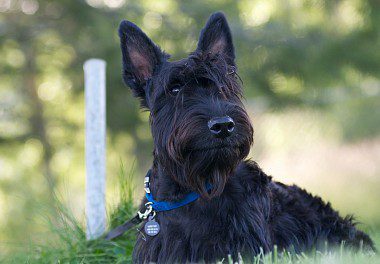
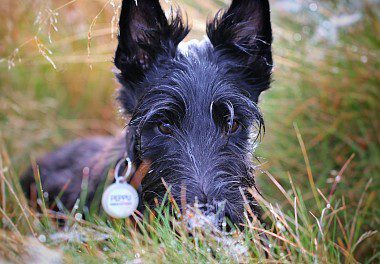
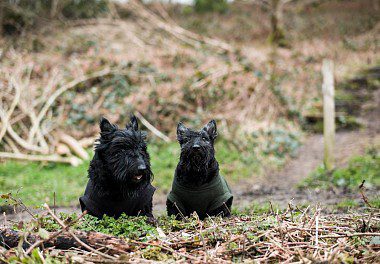
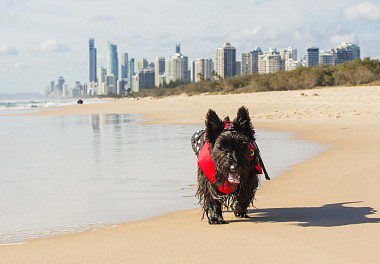
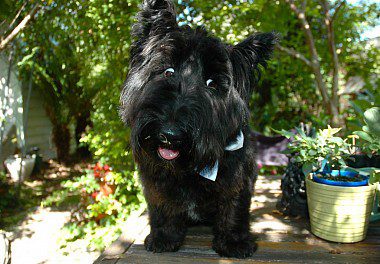
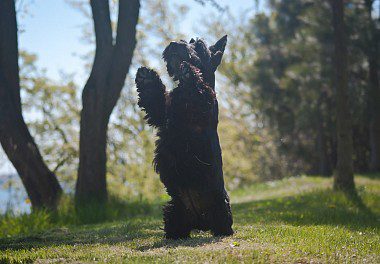
Scotch Terrier personality
The Scottish Terrier is a dog with character and a pronounced Napoleon complex, so do not expect to bring up a sentimental lazy person and sofa sissy out of it. Non-stop hugs, lazy reclining on the owner’s lap – this is not about Scotch Terriers. Proud and independent, they will not allow themselves to be turned into a living toy, no matter what privileges and goodies may loom before them.
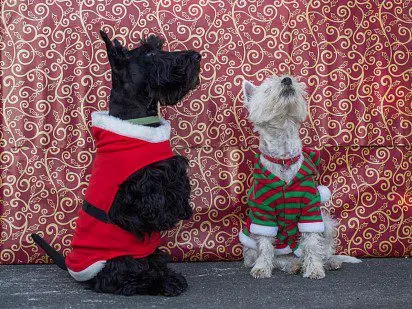
However, it is also not worth writing Scotties into the category of insensitive crackers, because for all their obstinacy, they experience an almost pathological attachment to the owner. Moreover, these bearded “energizers” are not at all averse to fooling around, lying together on the bed or taking on the function of a shaggy heating pad, but for this they need to wait for the appropriate mood. Scotch Terriers cannot and will not love under duress and command.
Scottish terriers are extremely curious, so they really need fresh experiences, which they try to stock up on for future use during walks. So put up with the fact that when Scotty goes outside, he examines all the minks and road potholes for the presence of living creatures in them. If those are not found, the dog will definitely try to compensate for the failure by ruining flower beds and lawns. But at home, the Scottish Terrier is a model of equanimity and good manners and can look out the window for hours, watching the drizzle and thinking about something of his own.
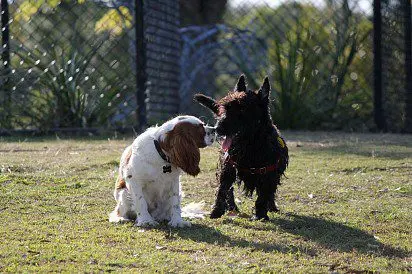
Representatives of this breed are extremely intelligent and do not suffer from excessive importunity: if the owner is sitting at work or watching an action movie, Scotty will not flicker before his eyes in an attempt to switch his attention. In extreme cases, he will simply settle down next to him, hinting that he is ready to share his leisure time. And for Scottish terriers, an emotional connection with the owner is very important, so often involve the dog in a joint pastime, whether it is cooking barbecue in nature or banal mopping.
The more an animal contacts with a person, the faster it develops, and vice versa – the less attention is paid to the Scotch Terrier, the more it withdraws into itself and becomes stupid. If the “Scot” spends his days alone, in an aviary, because you are too busy working or arranging your personal life, do not even hope that a friendly intellectual will grow out of him. The most you can count on is a hot-tempered fighter who hates tactile contact in all its manifestations. By the way, about fights: getting involved in them for Scotch Terriers is as natural as, for example, digging a hole. Moreover, Scotty absolutely does not care about the size of the enemy – he will attack the Alabai with the same fury as the Chihuahua.
Education and training
Extremely intelligent but extremely stubborn, can’t stand criticism but is very sensitive to praise and flattery – that’s all you need to know about the Scotch Terrier’s ability to learn. At first, Scotty is actively involved in the training process, but as soon as the lessons begin to lose their novelty effect, the dog moves on to other, more interesting activities. Another feature of the breed that is not the most pleasant for the cynologist is selectivity. The Scottish Terrier can excel at following commands that involve some exciting action (“Look!”) and deliberately ignore boring options like “Sit!”. You will have to get out of the situation with the help of affectionate persuasion and treats, other methods have little or no effect on Scotty.
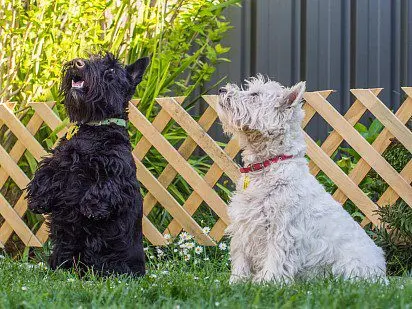
There are no special training programs for Scottish Terriers, although breeders do not get tired of repeating that teaching a “Scotchman” by the classical method is just a waste of time. It is better to combine the game and study, and cut the time of the lesson as much as possible. Scottish Terriers are not one of those dogs that work hard, overcoming boredom and fatigue. For the same reason, it makes no sense to take them to the training ground: classes there last a long time, which is already unbearable for representatives of this breed.
In order not to chase a pet driven by hunting instinct on a walk, teach him to walk on a leash before going outside, that is, from the age of three months. Consider also the fact that young Scotch Terriers are quite destructive, and there is no cure for this. Temporarily stash expensive shoes and refrain from over-engineering until your dog is older. Too insolent and presumptuous puppies are not forbidden to lightly spank with a newspaper / rag, but the method works only if the young bespredelnik understands what he gets a “bun” for.
It is known that little “Scots” love to bite, but you should not condone such outbursts of aggression, as well as abuse negative encouragement during puppy training. It is other dogs that perceive the owner’s cry as a stimulus. For the Scottish Terrier, such signals are a reason for unnecessary frustration and resentment. And one more thing: do not expect that in the very first lessons your kid will begin to demonstrate miracles of quick wits. This is the breed that needs to first evaluate the expediency of the given command and only then execute it, so do not burden the puppy with repeated repetitions of exercises and endless demands.
Hunting with Scottish Terrier
Today’s Scottish Terriers rarely hunt, but not because of the loss of the stalking instinct, but rather because of the reluctance of the owners to deal with the dog. Modern breeders rely on the image of pets, therefore, not every owner is ready to let his glamorous handsome man dig and get dirty in the ground. However, if the instinct of the getter is your everything, and you do not mind a little spoiling the external gloss of your “Scot”, visit the baiting stations, if any, in the area. There, the Scottish Terrier will be quickly reminded of its main purpose, and in a month or two, a highly skilled fox catcher and conqueror of the deepest holes will be walking next to you.
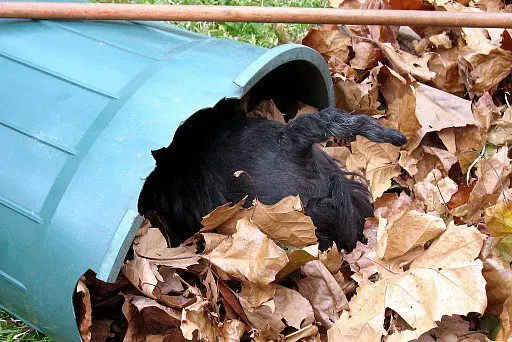
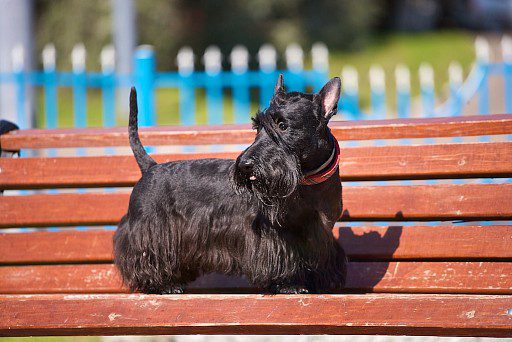
Maintenance and care
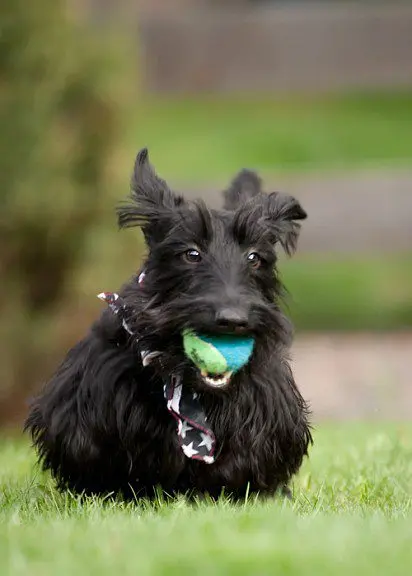
Scotch terriers feel great in small apartments, but subject to good walking. As for the placement of the puppy, the owners of nurseries recommend to settle the Scottish Terrier in the same room with the owner, because this breed needs close emotional contact with a person. And in this way it will be easier for the puppy to remember who his older friend and teacher is now. It is better to choose a bed for Scotty with low wooden sides (up to 10 cm) and install it so that it rises a couple of centimeters above the floor. This will protect the pet from insidious drafts. Toys in the life of a Scottish Terrier should also be present, but if necessary, they are a good substitute for an ordinary apple or cabbage stalk.
The floor in the room where the Scotch Terrier puppy lives will have to be covered with rugs or newspapers for the first time. On slippery surfaces, the baby’s paws move apart, and as a result, the dog develops an incorrect posture. By the way, about the set: until the Scottish terrier grows up, take him out for a walk on a leash, and not on a harness that deforms the already weak forelimbs of the baby. And in general, it is better to refuse this accessory if neither you nor your pet plan to “light up” in the ring in the future.
Scottish Terrier Walks
The Scottish Terrier is not a breed for adepts of passive pastime, if only because up to six months you will have to walk with a puppy every two to three hours. From six months to a year and a half, Scotties are taken outside up to four times a day. After the puppy is one and a half to two years old, you can switch to a permanent two-time walk, while the duration of each excursion should be at least two hours. If you don’t feel like hanging out in parks and squares for so long, take your four-legged friend to the promenade three times a day, reducing the time of one walk to 60 minutes.
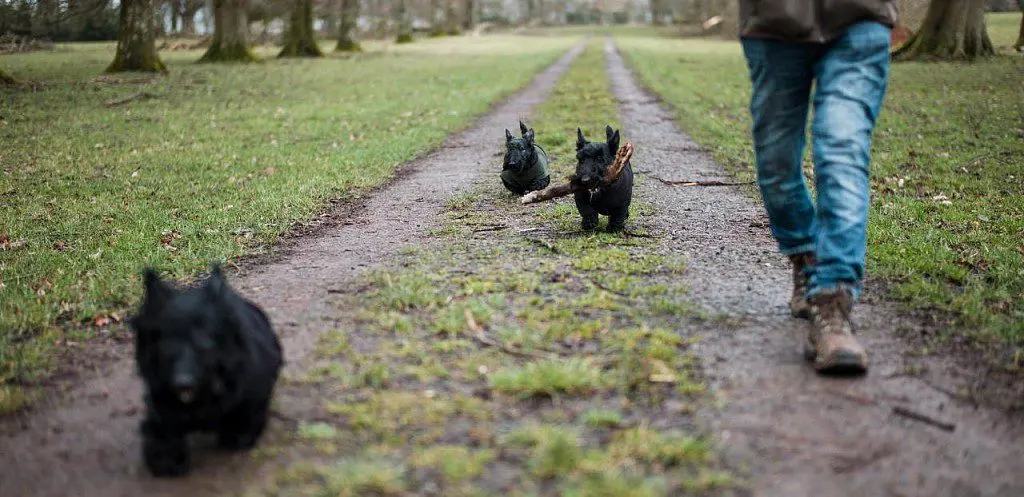
Hygiene
There is no seasonal molt in Scottish terriers. Twice a year, the undercoat is renewed in animals, but the guard hair remains in its place and dies off gradually. In this regard, Scotch Terriers are not sheared, but trimmed, choosing bundles of exfoliated wool. Usually, pinching is done twice a year in a grooming salon, where the specialist not only removes the dead undercoat from the dog, but also gives the dog the necessary breed features. However, some breeders recommend not being limited to seasonal grooming, but periodically pinching the Scottish Terrier on their own (once a month), removing dead hair all over the body.
Important: the first acquaintance of the Scotch Terrier with the procedure for pinching wool should take place no earlier than the animal is six months old.
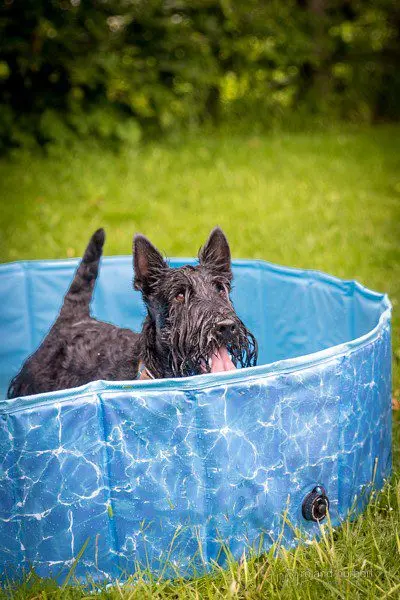
The most common mistake when home trimming a Scotch Terrier is leaving too much undercoat on his “panties” and “skirt”. Scotty is not a lapdog, and he does not need the fluttering hair on his thighs. Bathing Scottish Terriers is necessary once a month, rinsing coarse hair with a nourishing zoo shampoo and moisturizing it with conditioner or leave-in cream to facilitate combing. But this is all in theory. In practice, you have to wash the restless “Scots” almost five times a day. Not only does the “skirt” of the Scotch Terrier collect liquid dirt during walks, but the pet itself strives to dig in the ground and generously sprinkle its own “fur coat” with it. The purchase of protective overalls partially solves the problem of soiled wool, but only partially, so get used to the fact that without daily water procedures with this breed there is no way.
A little bit about combing Scottish terriers. Only clean wool can be tidied up: never try to comb a soiled dog that suddenly has tangles. First, wash the animal thoroughly, and you may not have to fight with matted hair at all. Scotch Terriers are combed in two stages: first with a brush, then with a comb with rare teeth. Tufts of wool that cannot be untangled can be carefully removed with a mat cutter. If the structure of your ward’s decorating hair leaves much to be desired, try rubbing an oil mixture with the addition of rosemary and cumin esters into the coat. Such “cosmetics” have not only a stimulating, but also a slight dirt-repellent effect, which is extremely important for Scottish Terriers.
Be sure to keep your dog’s beard clean. Wipe your pet’s face after each feeding, and even better – buy him a special flat bowl for food and an autodrinker. Scottie’s ears are healthy, so caring for them is not burdensome – a simple weekly cleaning of the auricle is enough. A little more attention will require the claws and eyes of the dog. The first grow very quickly, so they need a systematic haircut. The latter can react with inflammation to external stimuli, respectively, it may be necessary to wash the mucous membrane with chamomile or tea infusion from time to time.
Scottish Terrier Feeding
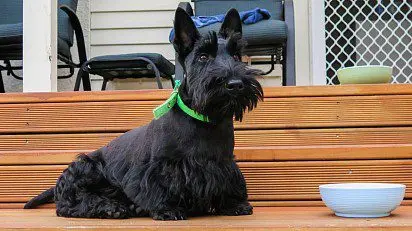
The primary source of protein for an adult Scotch Terrier is lean, raw beef. Lamb, like pork, is a time bomb for the liver and guaranteed diarrhea, so we immediately brush them aside. Boiled offal can be a good alternative to beef, but not more than a couple of times a week. By the way, Scottish terriers usually do not suffer from allergies, so turkey and chicken meat with pre-skinned is not forbidden to them.
Three or four times a month, the Scottish Terrier is pampered with boneless boiled sea fish. In addition, skimmed dairy products should always appear on the dog’s menu. From Scotty cereals, buckwheat and oatmeal are useful, from vegetables – carrots and cucumbers. Rice is also considered a nutritious cereal, but the “Scots” from it have difficulty with stool. A good support for the body will be natural dietary supplements like bone meal (just bones are banned) or vegetable oil, although mineral supplements from a pet store are also not the worst option.
If you plan on feeding your Scotch Terrier dry food, opt for Super Premium and Holistic. With this type of nutrition, additional vitamin and mineral complexes are not required.
And of course, you need to carefully monitor the condition of the dog. If the pet has lost a little weight, but is quite healthy, put more food in his bowl. The lazy people occupying the sofa, on the contrary, should cut their rations.
Health and disease of Scottish Terriers
Scottish Terriers inherited from their ancestors such unpleasant diseases as muscle cramps (Scotty Crump), hemophilia, Cushing’s syndrome, achondroplasia, dysplasia, pulmonary stenosis and retinal atrophy. Some of these ailments are detected in puppies within a few days after birth with the help of tests, while others cannot be diagnosed at an early age and make themselves felt when the dog is three to four years old.
How to choose a puppy
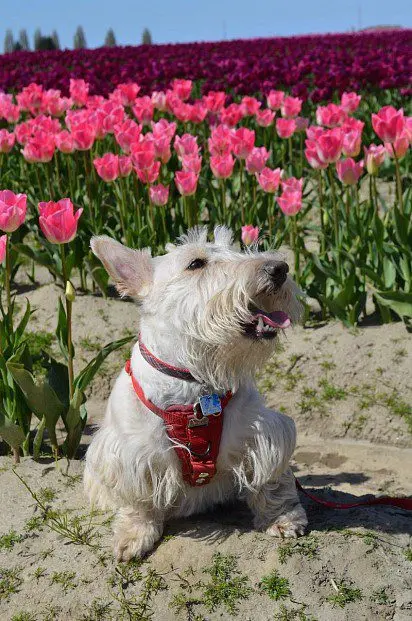
- Eight-week-old Scottish Terriers are extremely difficult to check for compliance with the standard, since puppies begin to acquire pedigree traits only at the fifth or sixth month of life. That is why it is important to contact an honest, proven nursery, where all offspring are obtained from planned matings and must be registered.
- If you are afraid to make a mistake in choosing, look for a breeder who sells six-month-old teenagers. At this age, it is much easier to determine the prospects of a Scottish terrier, but such a puppy will cost many times more than its two-month-old brothers and sisters.
- In Scotch Terrier puppies, the head is disproportionately developed and looks too massive. This is fine. If a two-month-old baby looks fully formed and looks like an adult animal, this is far from an advantage. Growing up, such individuals, as a rule, have a lightweight skeleton and a short skull.
- Check how healthy the puppy you like is. Look into his ears and the area under the tail: both there and there should be clean. There should be no redness in the inguinal cavities and under the armpits.
- Assess the type of temperament of the kids and their habits in the group. Too shy and slow Scotty is an unenviable acquisition.
- Refuse to buy a puppy that is too shaggy, with a well-haired skull, as with age it is likely to turn into a soft-haired fluffy, which is a serious defect for Scotch Terriers. It is better to look at babies with smooth fur, without traces of dressing hair.
Photo of Scotish Terrier puppies
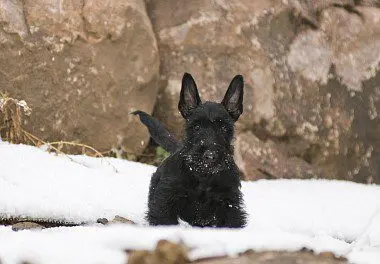
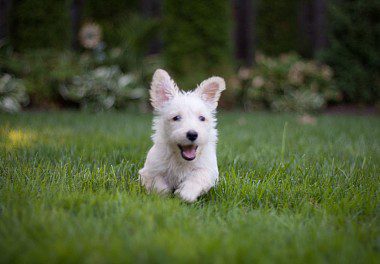
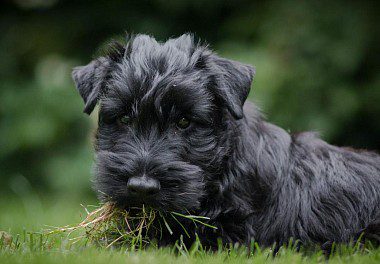
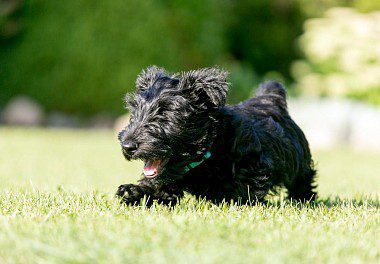
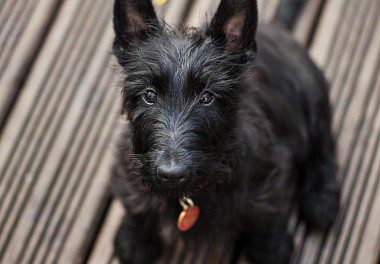
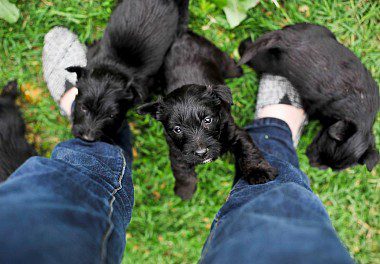
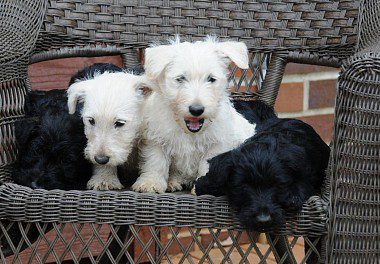
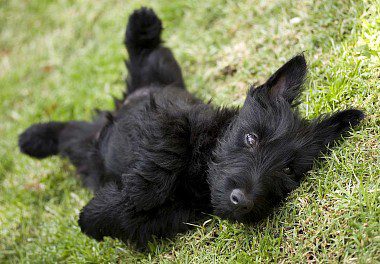
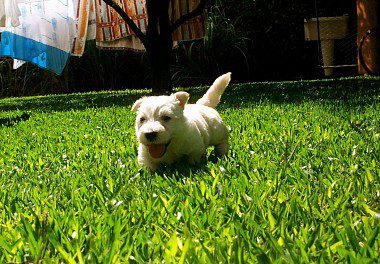
Scottish Terrier price
The cost of Scottish terrier puppies is determined not only by their belonging to a certain class (pet, show, breed), but also by the color of the animals. For example, there are always more ads for the sale of Scotties with black wool, respectively, and their prices are lower: about 500 – 600$. Wheaten Scottish Terriers are a phenomenon that is less common due to difficulties in breeding, but more expensive – from 800$ per puppy. The most expensive option is show-class Scottish Terriers with the right to breed. The price for these representatives of the canine elite ranges from 1400 to 1700$.



